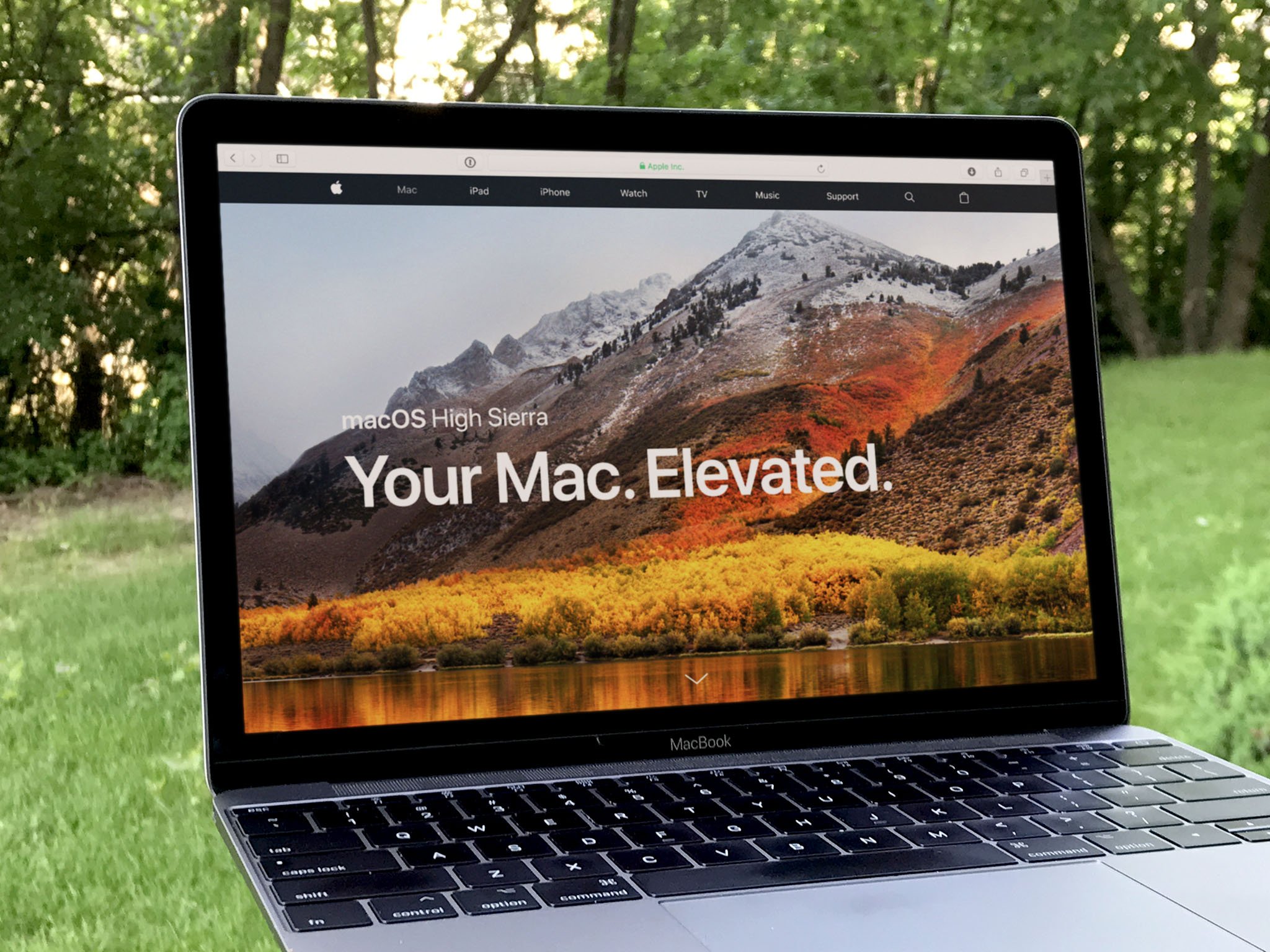macOS Sierra — 10.13 if you're keeping count — is named after the soaring elevations of the Sierra Nevada mountain range in California. It's part of a series of Mac operating systems Apple has been rolling out over the last few years. It started with Yosemite, after the National Park. Then zoomed in for El Capitan, out again for Sierra, and now up, way up, for High Sierra.
But High Sierra isn't about radical new heights. It's about radical new foundations. High Sierra combines new technologies with a new level of refinement. Not in design — that's stayed fairly consistent — but in usability. It harkens back OS X Snow Leopard, which was marketed as having "no new features". And smartly so. Grand Central Dispatch and Exchange support aside, it put the public's attention where Apple's had been: On making substantial improvements under-the-hood in order to deliver substantive improvements to the overall Mac experience.
So too, High Sierra.
There are new features in High Sierra too, of course, including support for virtual reality (VR) and significant additions to the Photos app, but the improvements to the foundation are even more impressive.
Cynics (who believe the Mac cup is half empty) will no doubt play High Sierra off as a side-benefit of what Apple's doing with iOS for iPhone and iPad. Optimists (with Mac cups half-full) will realize that's a false dichotomy. iOS was born of macOS and Apple has been sharing advances between them for years now. Most recently, the software teams have been better positioned to provide a more integrated, more unified infrastructure for both. And the advantages of that approach are wicked obvious. Not just for the teams, the operating systems, and the apps, but for us, the users.
Look no further than Apple File System, the biggest improvement in this release, if not this decade. Introduced over a year ago, already successfully rolled out to hundreds of millions of people through iOS 10.3, with High Sierra it comes fully to the Mac.
And that doesn't happen without shared talent and a unified focus. It's part of what makes High Sierra more than just a modifier shoved in front of last year's brand. It's what makes it part of what's next.
How to download and install macOS High Sierra on your Mac
macOS Sierra Evolution
macOS High Sierra is the thirteenth version of Apple's laptop and desktop operating system since the company acquired its foundations from NeXT. That's a lot of years and a lot of features. Here's a quick look back:
| Header Cell - Column 0 | Header Cell - Column 1 | Header Cell - Column 2 | Header Cell - Column 3 | Header Cell - Column 4 | Header Cell - Column 5 | Header Cell - Column 6 | Header Cell - Column 7 | Header Cell - Column 8 | Header Cell - Column 9 | Header Cell - Column 10 | Header Cell - Column 11 | Header Cell - Column 12 | Header Cell - Column 13 | Header Cell - Column 14 |
|---|---|---|---|---|---|---|---|---|---|---|---|---|---|---|
| Version | OS X 10.0 | OS X 10.1 | OS X 10.2 | OS X 10.3 | OS X 10.4 | OS X 10.5 | OS X 10.6 | OS X 10.7 | OS X 10.8 | OS X 10.9 | OS X 10.10 | OS X 10.11 | macOS 10.12 | macOS 10.13 |
| Release name | Cheetah | Puma | Jaguar | Panther | Tiger | Leopard | Snow Leopard | Lion | Mountain Lion | Mavericks | Yosemite | El Capitan | Sierra | High Sierra |
| Code name | Cheetah | Puma | Jaguar | Pinot | Merlot (PPC)Chardonnay (Intel) | Chablis | Snow Leopard | Barolo | Zinfandel | Cabernet | Syrah | Gala | Fuji | Lobo |
| Architecture | PowerPC | PowerPC | PowerPC | PowerPC | PowerPC/Intel | PowerPC/Intel | Intel | Intel | Intel | Intel | Intel | Intel | Intel | Intel |
| Features | Pre-emptive multitaskingMemory protectionAqua interface | PerformanceEnhanced CD/DVD supportEnhanced 3DImproved AppleScriptColorSync 4.0Image Capture | Address BookRendezvous/BonjourCUPS printingRevamped FinderSpam filteringWindows networkingQuartz ExtremeSherlock 3Universal AccessQuickTime 6PerformanceJournaling | Fast user switchingExposéFileVaultiChat AVX11 | SpotlightSafari RSSMail 2DashboardAutomatorVoiceOverQuickTime 7DashboardQuartz ComposerRosettaCore ImageCore DataCore Video | Back to My MacBoot CampStacks in DockCover Flow in FinderiCalSafari 3SpacesTime MachineCore AnimationRuby on Rails | QuickTime XSafari 4Cocoaized FinderImproved performanceExchange ActiveSyncGrand Central DispatchOpenCLBetter power management | AirDropPush NotificationAuto SaveAuto CorrectionFaceTimeLaunchpadMac App StoreMultitouch gesturesResume mode64-bit exclusive | NotesMessagesGame CenterAirPlay Mirroring | Multiple display supportTabbed FinderiBooksMapsiCloud KeychainTimer coalescingApp NapCompressed MemoryLinkedIn supportOpenGL 4.1OpenCL 1.2 | ContinuityExtensibilityPhotosiCloud DriveMail DropFamily Sharing | Split ViewEnhanced Mission ControlSpotlight intelligenceNotesTransitEnhanced MailEnhanced PhotosEnhanced SafariNew typographyMetal | SiriUniversal clipboardAuto UnlockiCloud DesktopApple PayOptimized storageEnhanced PhotosEnhanced MessagesEnhanced Apple MusicUniversal tabsPicture in PictureApple File System (beta) | Apple File SystemHEVC & HEIFMetal 2VR SupportPhotos enhancementsSafari enhancementsSiri enhancements |
| Release date | 3/24/2001 | 9/25/2001 | 8/23/2002 | 10/24/2003 | 4/29/2005 | 10/26/2007 | 8/28/2009 | 7/20/2011 | 7/25/2012 | 10/22/2013 | 10/16/2014 | 9/30/2015 | 9/20/2016 | 9/25/2017 |
| Price | $129.00 | Free | $129.00 | $129.00 | $129.00 | $129.00 | $29.00 | $29.00 | $19.00 | Free | Free | Free | Free | Free |
For more on past version and their features, please see my previous reviews:
macOS High Sierra Compatibility
You can download and install macOS Sierra, for free, on a range of hardware going back to late 2009. Basically, if your Mac is currently running Sierra, it can run High Sierra.
- iMac (Late 2009 & later)
- MacBook Air (2010 or newer)
- MacBook (Late 2009 or newer)
- Mac mini (2010 or newer)
- MacBook Pro (2010 or newer)
- Mac Pro (2010 or newer)
Some features, like HEVC encoding and decoding, require more recent models and processors.
macOS High Sierra Apple File System
APFS, the Apple File System was designed to replace the venerable HFS+ across all of Apple's devices. Though Apple had done an admirable job McGyver'ing HFS+ over the years, bubble gum and paper clips could take the Mac no further. So, it was time for something new. Something that was born for modern storage on state-of-the-art devices, and that could meet the needs not just of now, but of the near future as well.
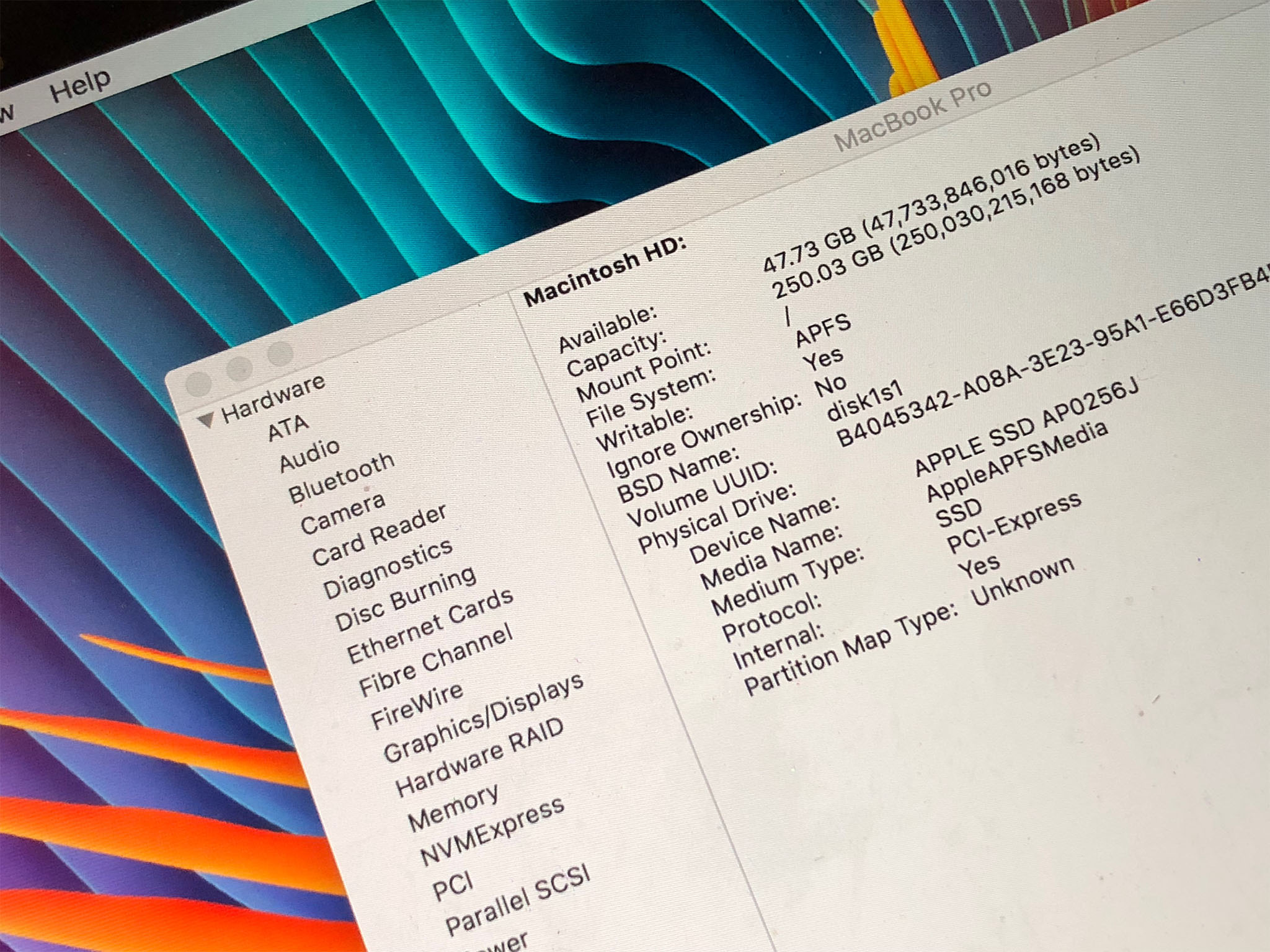
For more on the technical aspects of Apple File System, and how it's implemented on iOS, see my APFS primer. What Apple's doing specifically for macOS deserves a closer look.
HFS+ never understood full-disk encryption. So, FileVault used Disk Images and FileVault 2 relied on Core Storage. That limited the available features. APFS includes native support for encryption so Apple can offer it directly and in a way that allows for new features to be added over time.
There are differences in opinion about whether or not you should encrypt your home computer. Security experts believe fiercely in encryption, especially for work computers and laptops, and failing secure so, in the event of theft, no one can get your data. Backup experts believe encryption isn't always practical, especially for home computers and desktops, because theft is less likely than corruption, and failing safe means you may be able to recover irreplaceable photos and documents.
I believe in encrypting main drives and, for large personal photo and video albums, backing them up locally and to the cloud. That way, hopefully, data is safe from both theft and corruption.
And APFS makes all of that easier and better. Sapshots, for example, capture the state of the storage at a moment in time, without risking changes or collisions like HFS. For example, where HFS+ support for mobile Time Machine backups was buggy, APFS re-implements it completely on snapshots. Which also uses less storage and performs less I/O — it can do differentials at the block level — resulting in better performance.
Since my main Mac is mobile, and I own a Time Capsule, I'm really happy about this as well.
In HFS+, sparse files took up more space and required more time to read and write to than it should have. APFS, which should come as no surprise at this point, supports it natively. No problem, no wasted space or time. Some basic actions are also wicked fast. Because of cloning, APFS doesn't have to produce duplicate data when copying files. It can copy the metadata and and point back to the original. That takes almost no time and uses only a tiny amount of space. As changes accrue, it can record the differentials, making the process as efficient as possible.
The mental hurdle you have to clear, of course, is that if you make five copies of a big video, you save tremendous space… but if you then try to recover space by deleting those 4 extra copies (really clones) you won't recover much space at all. At least unless and until you delete the original, which you might not want to do. Trippy, right?
Apple does some smart interface and reporting work, including fast directory sizing, command line directory size tracking, and not hooking some of it up to the Finder, all to help make it file system magic more human understandable. For the most part it works. The rest is just coming to terms with the new normal.
If you use multiple partitions, which is something I used to do a lot but haven't in a while, APFS lets those partitions dynamically resize. Partition size used to be a huge pain when I rocked virtual machines galore, so past me appreciations this even if current me is long past rehab. The dynamic resizing does come at the expense of absolutely knowing the real size at any given point in time, but I'm a fan of abstracting away as much of the old comp sci cruft as we can from the computing process anyway. For most people, it's better.
Since macOS still fully supports HFS+ volumes, old and new, there's no reason to convert external drives if you don't have to — and it won't do it automatically. I left my old HDD externals on HFS+, though I did update my new SSD external to APFS. It means no one else in my circle of family and friends can use it until High Sierra goes into wide release, but such are the sacrifices of the preview process. And it works just fine.
For Macs with solid state drives, which includes all modern MacBooks, MacBooks Air, MacBooks Pro, and Macs Pro, installing High Sierra will automatically convert them to APFS. The process seems to be working extremely well now but, if you have any concerns whatsoever, make a backup. (During the beta there was a checkbox, on by default, for the conversion — that's gone in the release version.)
For Macs with Fusion Drives, High Sierra will neither offer nor allow any conversions to APFS right now. You could manually trigger the conversion in beta but Apple now recommends you roll back to HFS+ until APFS support returns in a future update. It's a complete pain in the apps but better safe than sorry.
When APFS does come to Fusion Drives, it should make a difference. Apple currently uses Core Storage as middleware to fool HFS+ into handling fused storage, but it only works at the block level and doesn't understand files or the exact kind of changes being made to them. APFS does. It can make better, more intelligent decisions about what kind of data goes where. For example, it can make sure metadata is always on the SSD so random access is always faster.
I've been using a fusion drive on a 2015 iMac and… it's not my favorite. Once you get used to SSD like on MacBooks and MacBooks Pro, it's hard to go back, even to fusion. So, every time the platters spin up, so do my nerves. I don't think APFS can fix my core concerns with Fusion, but I do hope it can take the edge off. Even if only slightly.
Even on solid state only, APFS has been working great. I've converted several systems over without any issues. In daily use, I can't say I've noticed tremendous differences yet. But that's the point. Converting however many hundreds of millions of iOS devices and, now, however many tens of millions of Macs, without issue, and with a file system ready for the next decade?
That requires an incredible amount of chutzpah and hard work. And damn if Apple didn't pull it off.
macOS High Sierra HEVC (H.265) and HEIF
Once upon a time, we had H.264. We liked it. It was fast and it was good. It let us download and stream our 720p and 1080p video in seconds and minutes instead of minutes and hours. But now our video has grown four times bigger with 4K (2160p) and gotten deeper with high-dynamic range (HDR). For that, H.264 was no longer so fast or so good.

While Apple has announced iTunes 4K HDR content for the new Apple TV 4K, no similar announcement has yet been made for the iMac 4K or iMac 5K. It's possible Apple is still in negotiations with the notoriously paranoid and DRM-crazed Hollywood over Mac licensing. Hopefully, we'll hear more about later in the year.
HDR is technically separate from 4K, so it's possible we'll get the better color gamut and gamma regardless of the resolution.
So, the consortium of licensors (feel free to think of more colorful names to call them) have given us H.265, which they went to all the trouble of re-branding the even less-enjoyable-to-say high efficiency video codec: HEVC. Gesundheit.
The efficiency in the name works out to about 40% over H.264, typically at the expense of longer encode times up front. (Very little in life, and nothing in video, is free.)
With macOS Sierra, Apple is building in support for both HEVC encode and decode. On a Skylake Mac (late 2015 and 2016), you get the 8-bit Main profile which handles 4K. On a Kaby Lake Mac (mid 2017), you get the 10-bit Main 10 profile, which handles 4K HDR.
The hardware is what takes care of the acceleration. macOS is what takes care of the smarts. It turns the greater amount of knobs available in HEVC to provide as high a quality with as high a performance as possible. That frees up the main processor for other tasks, improving the overall feeling of speed and responsiveness.
Of course, there's currently very little content available yet for HEVC. Even the big media players, like Amazon and Netflix, are barely trickling out support for it, and not at all on the Mac.
Likewise, while Apple has announced iTunes 4K HDR for the new Apple TV 4K, it's not yet available on the Mac. Given Hollywood's horrible track record when it comes to DRM demands — which never stop pirates but always interfere with legitimate customers — it's going to be a tough needle to thread.
So, right now, HEVC support will appeal mostly to video professionals and transcoders.
High-efficiency image format, or HEIF, is the photo version of HEVC. Nightwing to its Batman. it offers 2x better compression than trusty old JPG and what's more — it stores multiple assets in the same container.
For example, let's say you take a Portrait Mode or Live photo on your iPhone Plus running iOS 11. Where previously the depth data for Portrait Mode or the still and motion elements of a Live Photo were stored separately, HEIF bundles them all together. (HDR data, which is taken from multiple exposures, starts being processed at the ISP-level in the chipset, so that's burned in before it can be bundled into HEIF.)

macOS devices don't take Portrait Mode or Live Photos yet but they can edit them. And that's where the advantage of HEIF come into play. Filters, for example, can now apply different effects based on the depth or motion data.
It's also going to be important as we continue our march towards things like Portrait Mode, Portrait Lighting, and the computational photography that'll go well beyond lenses in the future.
Some of this does come at the cost of compatibility with older systems. macOS can and will share H.264 and JPG versions of your videos and photos to people running devices without HEVC or HEIF support, for example, using AirDrop or Mail.
If you simply grab the raw files and copy them around, sneaker-net style, older apps might not know what to do with them. Early adopter be warned.
Likewise, some apps like Adobe Photoshop don't yet support HEIF. You'd think Adobe would make it a point-of-pride to have HEIF added early on in the beta cycle, if not well in time for release. Sadly, not. Hopefully, Apple's implementation will help drive HEIF support across the industry. And soon.
macOS High Sierra Metal 2, Core ML, and Virtual Reality
When Apple introduced Metal, a new graphics framework that sidestepped the depthy cruft of OpenGL and let developers write much, much closer to the… metal, the company claimed a 10x improvement to draw calls. With Metal 2, the company is claiming a 10x improvement over the original, for a total of 100x over GL. That's ballsy to say the least.
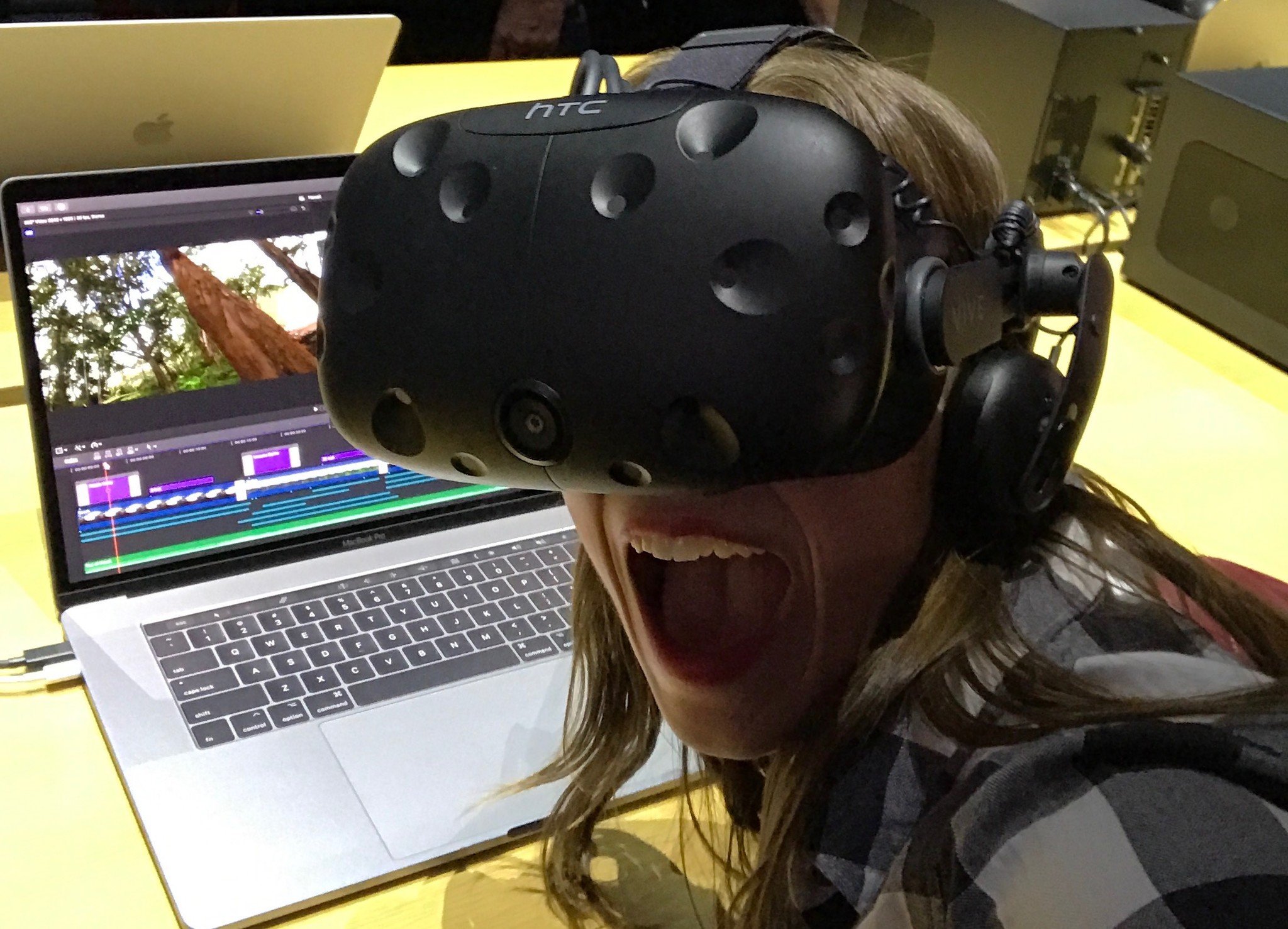
Apple really wants to deliver on the promise of technologies like Core ML, its new, high-level common format for machine learning models, and the lower-level computer vision kernels for image processing, linear algebra, convolutional neural networks, and algorithms behind it.
To do that, it has to make it easier to get the CPU out of the way and tap into the computational power of modern graphics processors. I can't even pretend to understand all this, but the way that it's been explained-to-me-like-I'm-a-three-year-old by much smarter friends and colleagues is that it's offering new commands that allow more to be submitted and referenced in advance, it no longer needs to reset so it can copy less data and send fewer commands, and all of that reduces overhead and increases performance. Woof.
Also, where the original Metal varied in some areas between Apple's platforms, Metal 2 is unified. There are still a few differences because Apple's devices remain different, but there's now feature parity wherever possible, which means code can be shared more easily whenever possible.
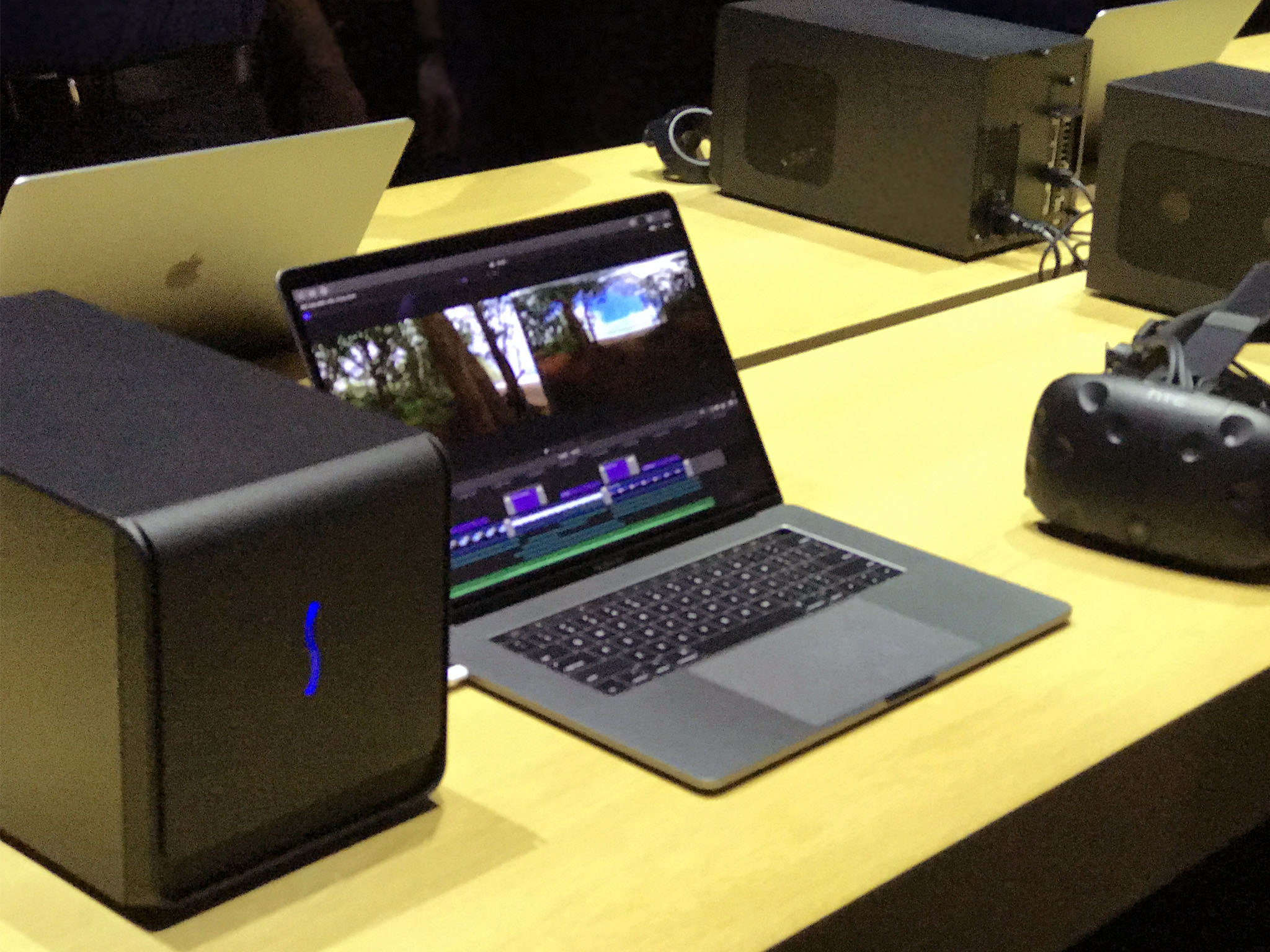
The macOS windowing server in High Sierra is implemented on top of Metal 2, so everything on screen from draws to compositing to animation to scrolling is smoother. (I didn't say "buttery smooth" so you can't drink!)
Of course, all that buttery smooth (d'oh!) new windowing isn't helped by the lack of advancement in features like Split View. I use it all the time on the 12-inch MacBook, same as I do on the iPad, but while the iOS version started better and has become much, much better, the macOS version has been left in the same frustrating state as it was at launch — with no ability to change the apps in an existing Split View, only to destroy it and start over. Maybe 10.14?
Speaking of being bummed, I know some people are still grumpy that Apple is using an Apple-specific framework for all this new graphical goodness, and not something standards-based like OpenGL was, and that's fair enough. Sometimes Apple chooses to control its own destiny and sometimes that lets Apple move faster, more efficiently, and more specifically than standards-based process or cross-platform technology would allow.
Famously, Apple's lack of investment in Mac graphics hurt the platform when it came to virtual reality (VR). When Oculus first announced the Rift, I bought one. Because of course I did. Then, when I found out it wouldn't work on the Mac, I lent it to a friend so she could have fun with it on her PC gaming rig. I'm not PC angry, but I didn't want to have to set up and maintain another computer system just to enjoy the occasional VR experience.
The whole time, though, I hoped — and complained about the lack of support — for VR on the Mac. High Sierra is beginning to answer those hopes — and shut up those complaints.
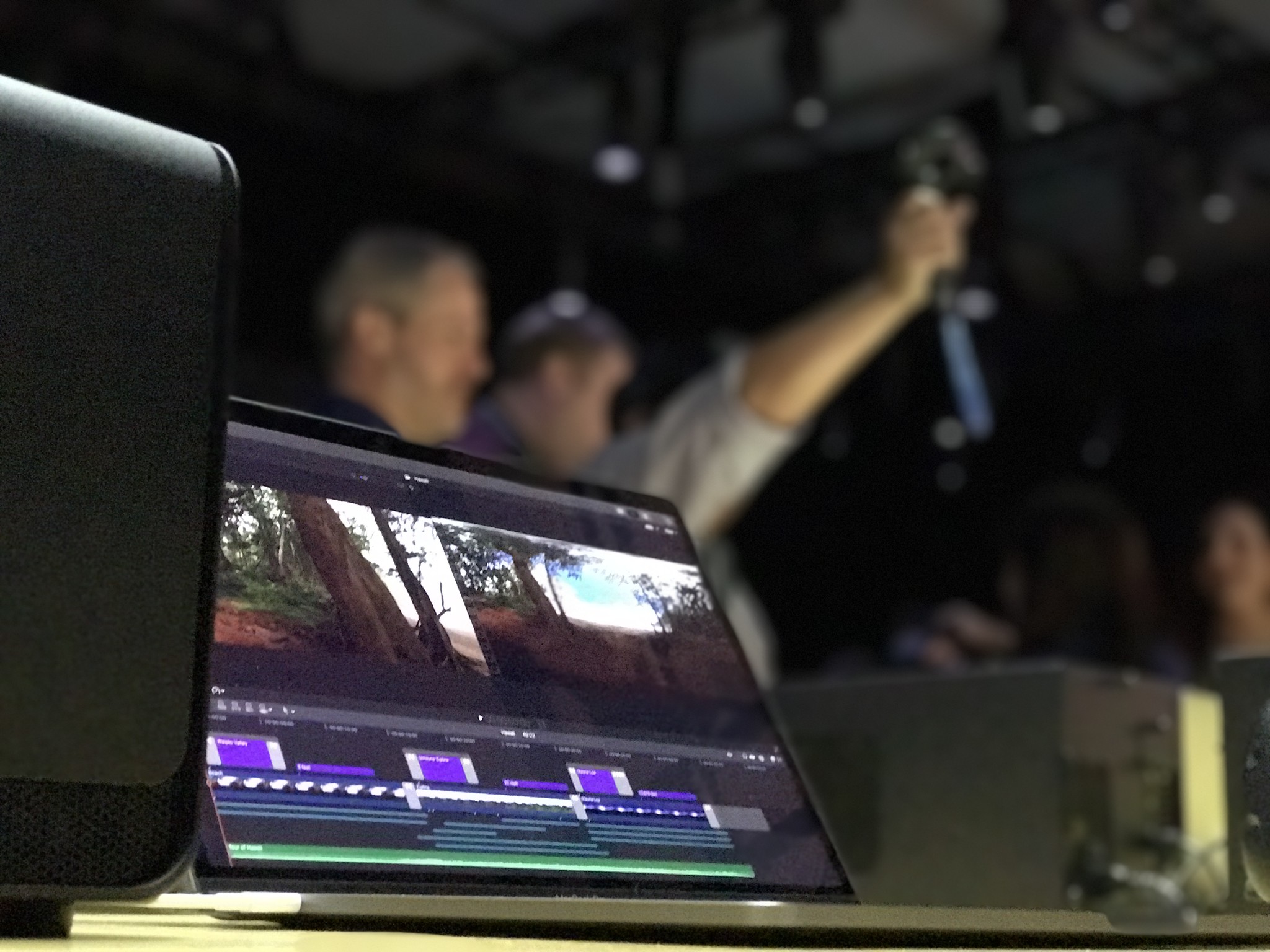
On the hardware side, the latest iMacs finally have enough graphics muscle to support VR and — currently in developer beta but going into general release in the spring of 2018 — external graphics processors (eGPU) will open up that support to the MacBook Pro as well. (macOS has never had to account for GPUs that could appear or disappear before, so all of that is being accounted for in High Sierra, including detection, notification, and loss handling.)
That requires a hefty helping hand on the software side too, which again brings us back to Metal 2.
For VR, Apple is doing everything possible to provide for extremely low latency and solid, high frame-rates between the Mac and head-mounted displays like the HTC Vive. As soon a s VR display is connected, macOS High Sierra will detect it and get as much of the rest of the software stack out of the way as possible. Then, an optimized rendering path takes over.
There are also new performance tools for developers building VR applications, including system trace for VR timelines and per-eye visualization in the debugger. Much of that is as over-my-head as Metal, but it excites the VR nerds I've spoken with and that excites me.
What's not as clear yet is how much support there'll be for native VR gaming on the Mac. Steam is on board, and to quote my colleague, Russell Holly of VRHeads.com, it looks like both they and Apple are doing everything right. So, fingers crossed. Worst case, there's always Boot Camp, but I'd prefer not having to maintain that environment if I don't have to either.
Regardless, I'll be testing the eGPU and the iMac on VR over the summer, so stay tuned for more.
macOS High Sierra Photos
I have a love-hate relationship with Photos for macOS. I love how integrated it is with Photos for iOS, and how well it excels at basic photo and video management and editing. But I miss being able to drag-and-drop into several of the non-Apple apps I use, and I really miss being able to right-click and open in Photoshop or another external editor, which I did near-constantly in Aperture.
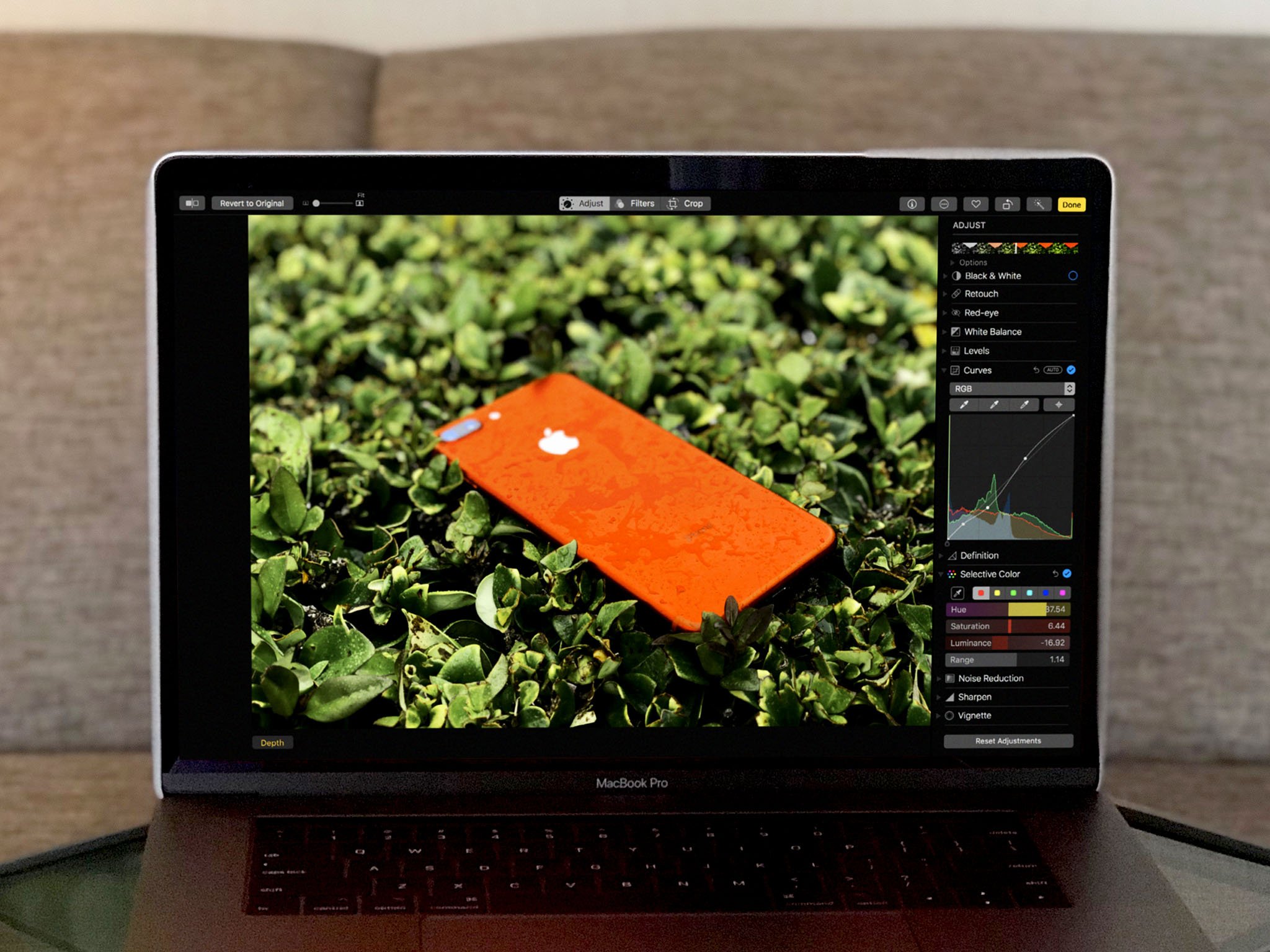
At the same time, just as it delivers the top-most features on my wish list, High Sierra trolls me by improving its own editing enough that I now don't need an external editor anywhere nearly as often. That includes new tools like curves and selective color. Best of all, they're auto-magic enough that you don't have to be a Photoshop wizard to use them.
For example, you can choose selective color to take a photo of your red iPhone sitting on green leaves, pull all the saturation from the green, and then push the red towards purple. And boom, whole new photo.
It's so quick and easy that, back in June, for the first time ever, I moved a photo from Photoshop to Photos to finish it. Yeah, I was surprised too!
A lot of this is also available in Photos for iOS 11 — unified foundations have their advantages! — and when it comes to quick editing to post on Instagram or other social networks, I prefer doing it on iPhone. iPad is also a joy to edit on. For big batches of images, I still prefer the Mac, so these new tools being available here as well are great.
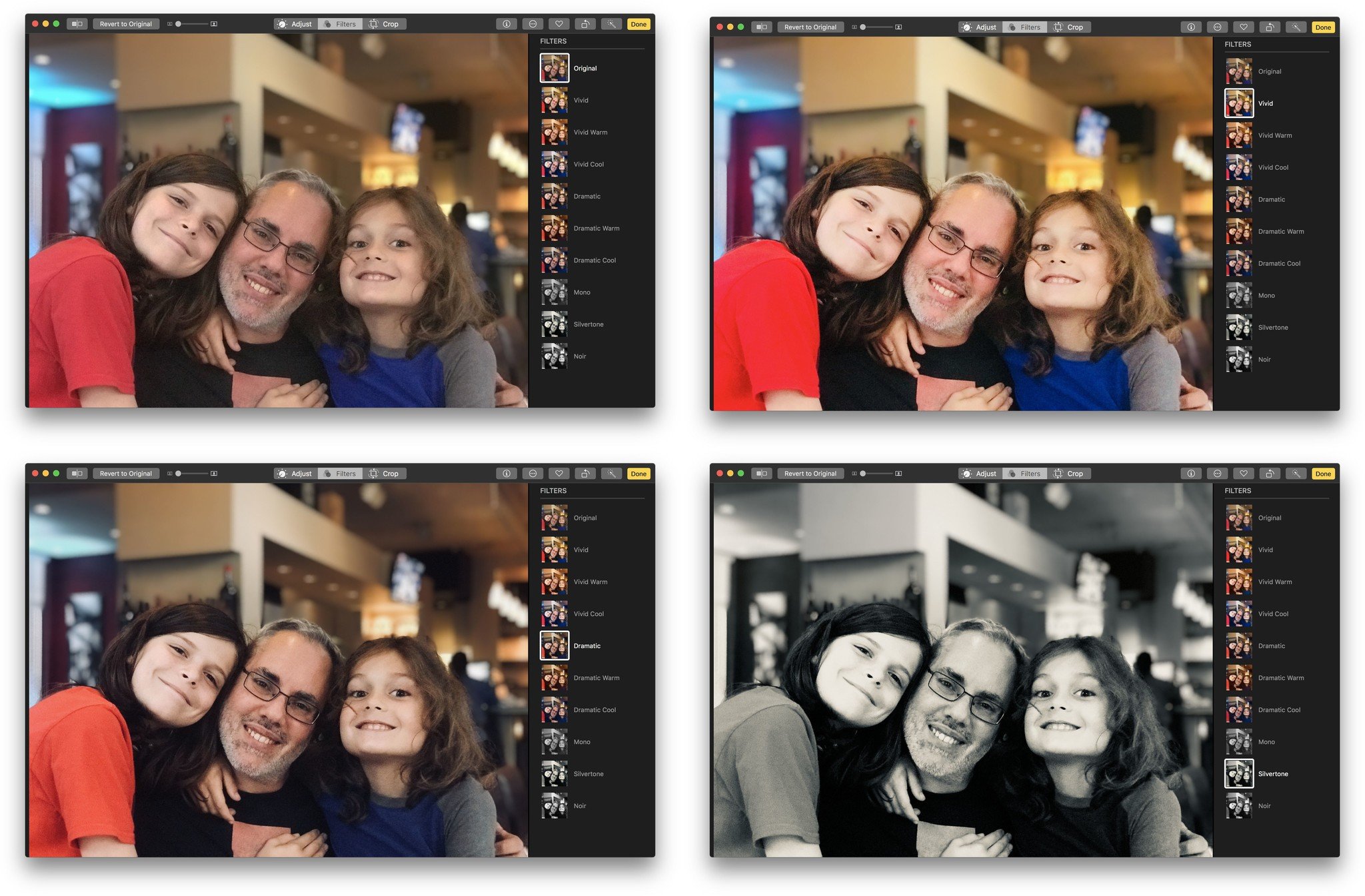
The same filters are available here as on iOS as well, including the ones that use the Portrait Mode depth data to render effects. Speaking of which, you can toggle Portrait Mode on and off using the "Depth" button at the bottom of the photo in Edit mode.
One word of caution: If you try to edit an iPhone 8 or iPhone X Portrait Lighting photo, and toggle depth off and back on, you'll lose the lighting effect, at least in the current version. To get it back, you'll have to re-edit on your iPhone 8 or iPhone X.
Photos for macOS also lets you add and edit the new Live Photo effects, Loop, Bounce, and Long exposure. They're fun and I'm sure I'll end up using them more on iPhone and for Instagram, but sometimes I'm at my Mac when inspiration strikes and not having to reach for my iPhone is huge convenience.
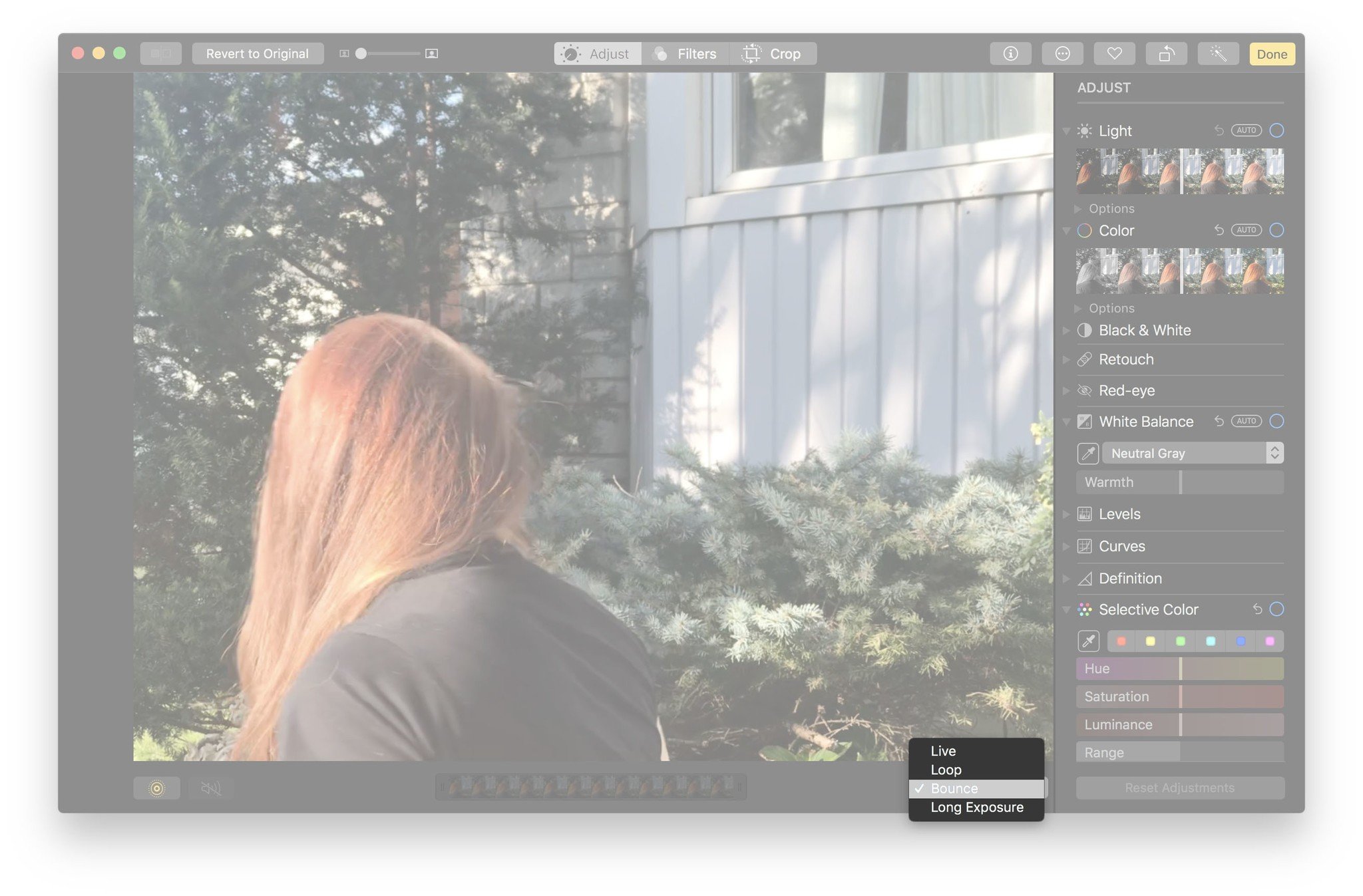
That's especially true for memories. Confession: I find them kind of annoying on iPhone. I'm usually busy when I have my phone in my hand so I don't have the patience for the notifications or the time to explore and share memories. When I'm on my iPad or Mac, it's a different story. Especially my Mac. On my Mac, a memory will pop up in the corner or the bottom of a photo I'm looking at and I'll smile, and more often than I expect, I'll share it.
Same for the new third-party extensions that allow you to order framed prints and other IRL manifestations of your photos. I've had a chance to see some samples and they're just what you'd expect: Extremely clean, extremely well printed, and extremely high quality. The holiday season will be telling, but I have some strong preconceptions about how I'll end up using them. I may yet be proven wrong, but my guess is grabbing a one-off or impulse items will be awesome on iPhone. Planning something really special, though, will again better on iPad and, dare I propose, still even better for me on the Mac.
What I've really been waiting for, though, is Faces sync. When Apple initially re-deployed facial recognition and tagging last year, the company said syncing would come later.
Well, later is now. And the reason it took so long is that Apple wanted to provide the convenience of sync while maintaining the privacy and security of on-device processing — Apple doesn't want to know who your friends and connections are, and I'm supremely thankful for that.
So, what Apple's doing is interesting. To enable face detection, you have to start selecting people you know and then identifying them. At that point, the on-device machine learning and computer vision takes over and starts to add more and more pictures of the identified people to the pool.
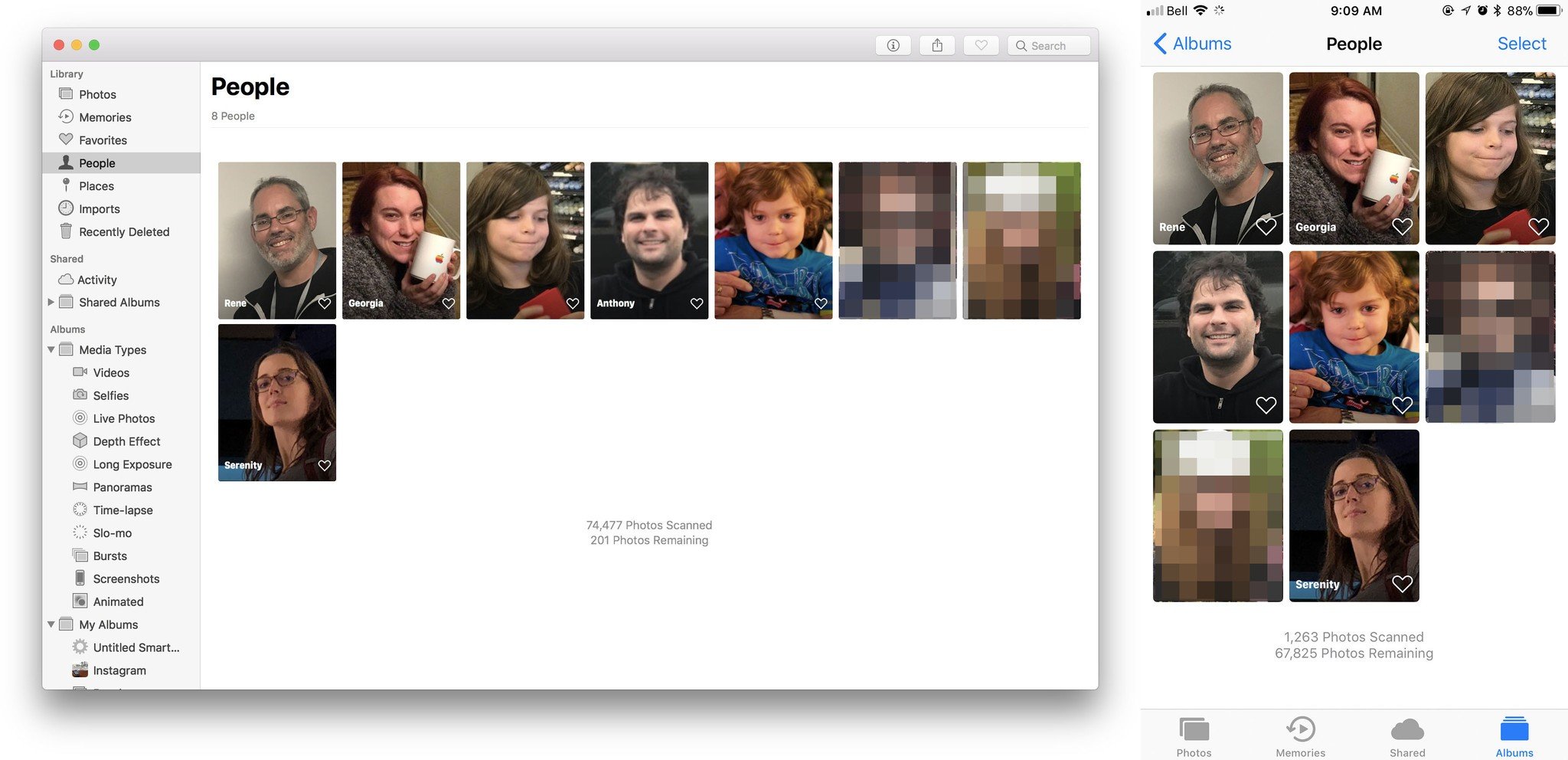
When syncing, Apple is only moving over the data you yourself identified. None of the machine learning or computer vision relationships that were built around it. Just your "truth". Then, the synced device rebuilds those relationships locally.
In other words, I tag pictures of my mom on my iPhone, it finds other pictures of my mom on my iPhone to add to her Faces folder on my iPhone. The pictures I tagged are also synced to my Mac, which then also finds other pictures of my mom on my Mac to add to her Faces folder on my Mac.
Apple will have to prove that this implementation works well enough that people who want no part of the massive data harvest that is Google Photos will still find it useful enough to use, and that'll take a while post-launch to really shake out.
Still, privacy is good and options are good, and options for privacy are great.
macOS High Sierra Safari
Safari has been my go-to web browser for years. It's gotten to the point where I only install Chrome on a Mac when and if I have to. And most recently, I haven't had to.
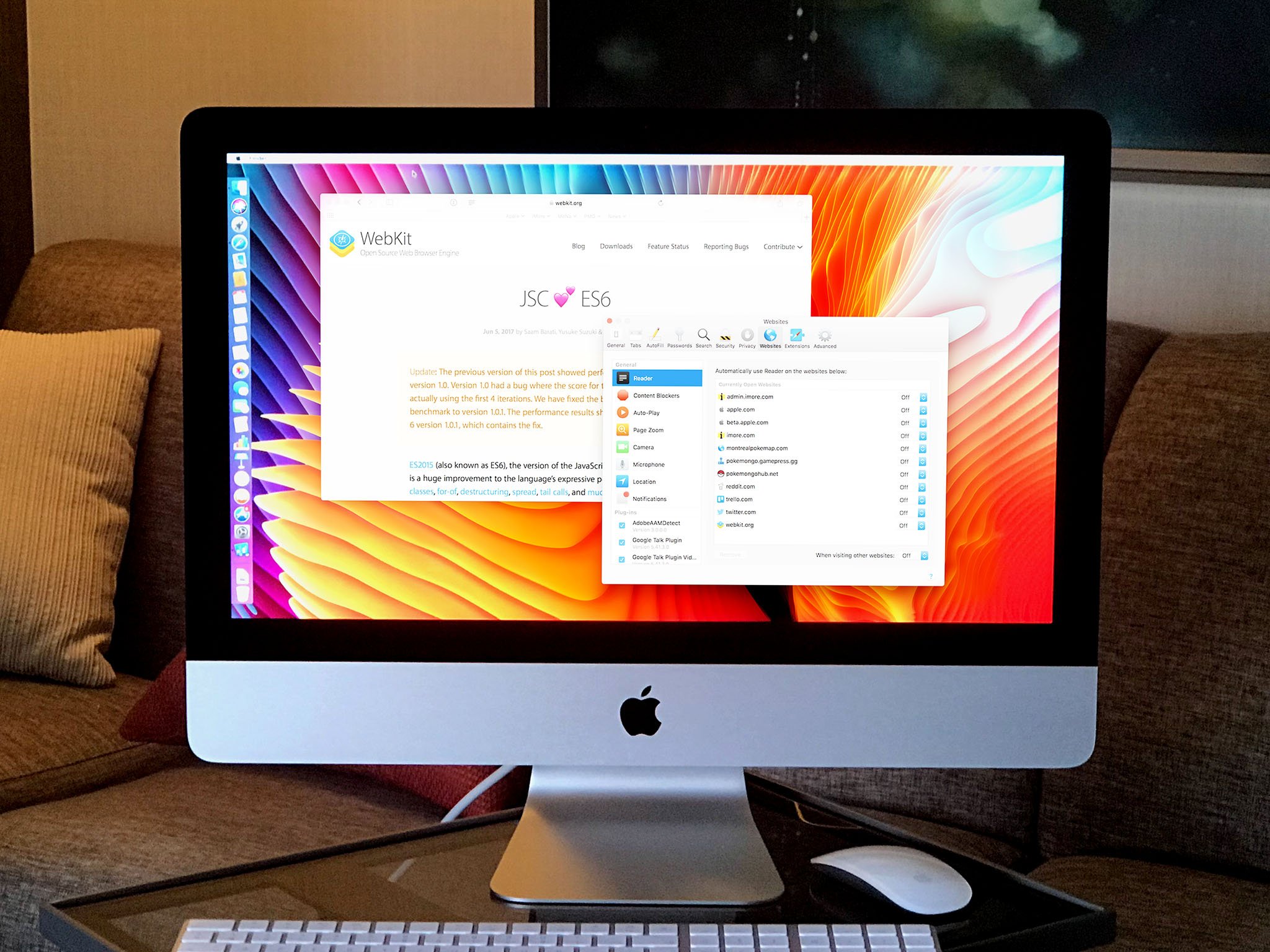
Safari is just so much lighter, both in interface and power draw, that it better fits the modern, mobile world. Because I work on the web and spend most of my day in a browser, whatever improvements Apple makes to Safari, and its underlying technologies like WebKit, affect me directly. And it's great to see Apple still pushing that forward.
Yes, relentless performance and zero regression are alive and well. Apple strongly believes Safari is the fastest web browser on the planet and the company is going to make sure it not only stays that way, but that everyone knows about it.
There are some new features in Safari for macOS High Sierra as well, including automatically blocking auto-play videos. That's not just video ads either but sites that start playing video right away to buff up their view numbers. If you've ever had silly sounds pop out of your Mac at the worst possible time — cough, senior staff meetings, cough — you'll really appreciate this.
Safari will also block trackers. Advertising companies use trackers to try and build profiles to serve more compelling ads and to make sure they don't pay to serve the same person the same ad more than a handful of times. (Because, after that, you've either already clicked on it or, more likely, already decided it's something you're not going to click on — and advertisers are nothing if not frugal to a fault.)
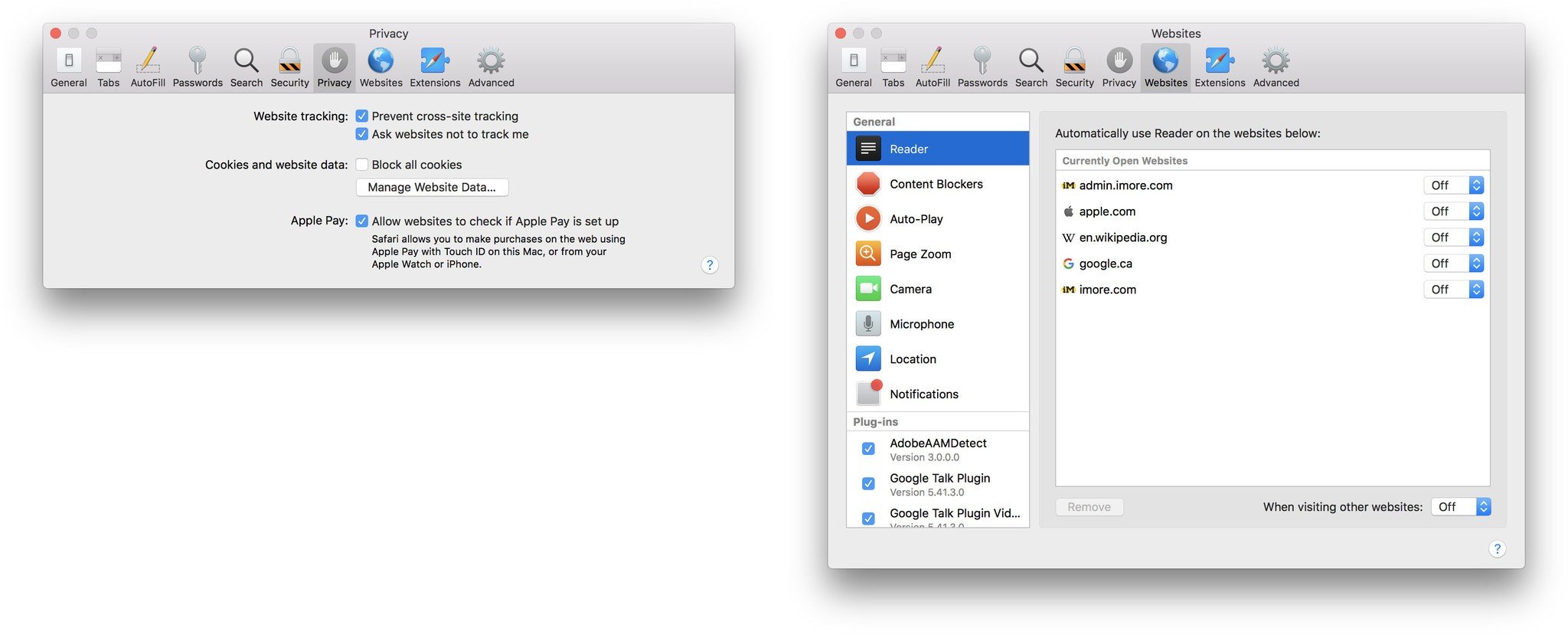
Since ads are super dumb and normally don't know about each other, they don't share trackers but rather spin up multiple instances of even the same tracker multiple times on the same page. That in no way helps the advertisers with their goals but absolutely kills performance on the page.
As disheartening as it is for some of us to believe, it's not the privacy that bothers most people — otherwise we'd be far, far more careful about all the data we're already handing over to Google and Facebook in exchange for "free" services. It's the impact on performance. We don't all hate giving away data but we all seem to hate our browsers being slow.
Regardless, this solves for that. And what's more, Safari for High Sierra lets you save settings per site. So, you do things like defaulting certain sites to Reader Mode if that's what you want.
There's a lot more too, including: WebRTC, HEVC for more efficiency web video, variable fonts so great typography stays looking great across different screens and resolutions, CSS fill and stroke, CSS Grid so everyone finally stops using tables (right?), CSS scroll snap because web apps need all the scrolling help they can get, and Gamepad support for online games.
Also, WebAssembly so you can get binary with it on the web, SharedArrayBuffer because JavaScript deserves to be multi-CPU aware too, Fetch API to bring resource loading out of the stone ages, DOM JIT because the object model needs to be just-in-time too, HTML custom elements because easier code reuse is easier, offscreen canvas to make web animations silky smoother, indexed database API 2.0 because persistent storage for web apps needs as much 2.0 as it can get, and input events and point lock to better control interactivity,
And URL standard for better parsing compatibility across browsers, resource and user timing to help analyze web performance or the lack thereof, visual viewport so responsive design can pan, zoom, and handle other changes, concurrent garbage collection so it stops janking up your browsing, and HTTP immutable responses for better security and performance.
Phew.
macOS High Sierra Miscellany
Siri for macOS High Sierra gets the same new, more natural voice as Siri for iOS, and the same, new, more circular icon just like on the top of HomePod. There's also music integration for recommendations, playlist creation, and general information.
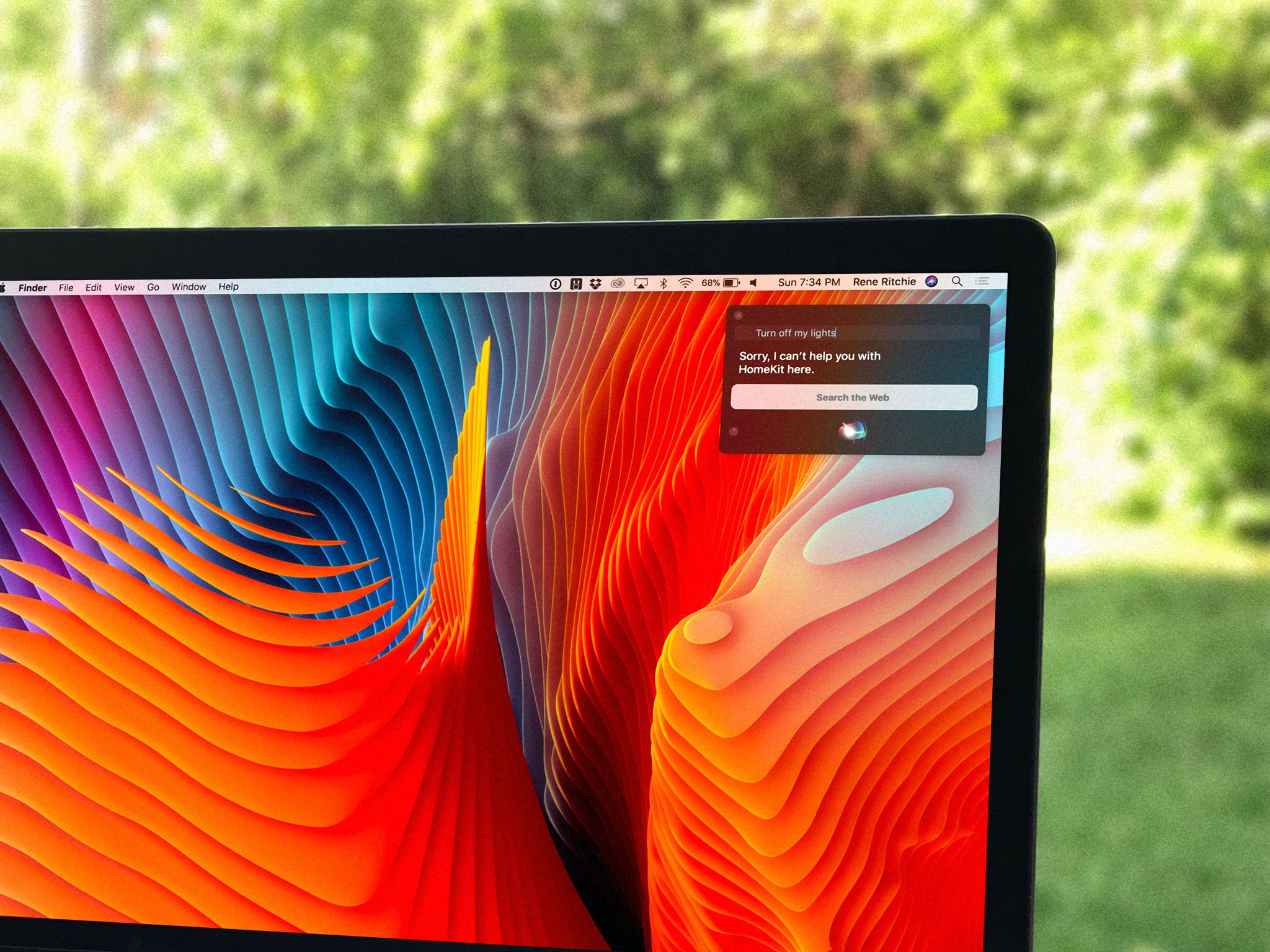
There's still no sign of HomeKit support, though, which is a huge bummer. I'd love to be able to tap Siri on the Touch Bar and turn my lights on or off without having to reach for an iOS device or remote.
Along the same lines, even though Continuity was introduced three versions ago, there's still no support for media, which means I can't be listening to a playlist on my Mac, get up and walk away, and keep listening on my iPhone without missing a beat.
I miss all the beats — unless I manually tap through to find and play the same list, or ask Siri to find and restart it. Yes, like an animal.
Given the great lengths Apple has gone to make its platforms such a uniform, consistent experience, it only sticks out all the more when gaps like this remain year after year after year.
Auto Unlock is updated to provide support for the W2-powered Apple Watch Series 3. (You'll need to update if you got a new Watch.)
Universal Clipboard has graduated from text and images to full on files. It now lets you copy and paste documents between Macs using just the power of Apple ID, iCloud, Bluetooth LE, and point-to-point Wi-Fi alone. That's a geeky way of saying hit CMD-C on one Mac, move over to another Mac that's also logged into your account, and hit CMD-V. Boom, Continuity file copying. It's great and now that we have Files.app on iOS, I hope it goes cross-platform as well.
Spotlight, still around and kicking in the age of voice, now gives you flight numbers, arrival and departure times, terminal and gate info, update you on flight delays, and show you a map of the flight path. There's also support for constellations and, hurrah, multiple Wikipedia results.
Accessibility offers Type to Siri, which has been on my wish-list for a long time as well. (Sadly, inverse colors doesn't seem to be as smart as the new iOS 11 version, at least not yet.)
For iCloud, you'll be able to share an iCloud Drive link the way you've been able to share a Dropbox link for a while. Just copy it, send it, and whomever you share it with will be all up in your file or files with you. (Yes, share wisely.)
Files you share can be used in any compatible app and you can control access. So, for example, anyone can view one file but only specific Apple IDs can edit another. Think Google Docs sharing but for iCloud.
Mail is faster and now shows top hits based on a variety of factors, including how often you engage with the sender. It's supposed to get better the more you use it. I've found it a bit of a mixed blessing since I often search for mail that comes from senders I typically don't engage with — like for order status or shipping info. I'll give it time, but I currently feel lost more often than I did staring at the long list of literal results.
Notes lets you pin notes at the top of the list and also add tables. Since its launch, I've pretty much lived in Notes for most of my writing. It's my figurative mind palace. But with sync. It doesn't get all the fancy new features like document scanning or, obviously, Instant Access via Apple Pencil, but I'll take any improvements I can get.
I'd still kill for a plain text mode. Hard.
I also wish Instant Markup for screenshots was included in macOS High Sierra the way it is in iOS 11, because Mac users want to complain, taunt, and tease via screenshot too.
FaceTime lets you grab Live Photos during video calls. It's terrific fun in the best Photo Booth sense of the word. There are no effects, like Photo Booth, but there's every bit the sense of grabbing onto and holding a special moment. And since it uses the camera on the other end of the conversation, you get much better quality than simply screenshot, compressed video quality. You get everything the other device can deliver. In motion.
Still waiting on FaceTime conference calling.
There's also bilingual English support, autocorrect, auto word-list updating, and better video captioning for Japan; safe browsing and local points of interest for China, Hindi as a system language, a Nastaliq font, SF Arabic system font, and new bilingual dictionaries for Russian and Portuguese.
macOS High Sierra Conclusion
macOS High Sierra will win over most customers with precisely one feature: It's free. But I also think it'll win more than its fair share of fans on the strength of its new technologies and refinements. For people like me who have been looking for VR support or waiting on a few extra features for everyday apps like Photos or Notes, or wanted Faces to sync, it'll be a clear win. (iMessage sync was supposed to come as well at launch but has been delayed until a future update.)
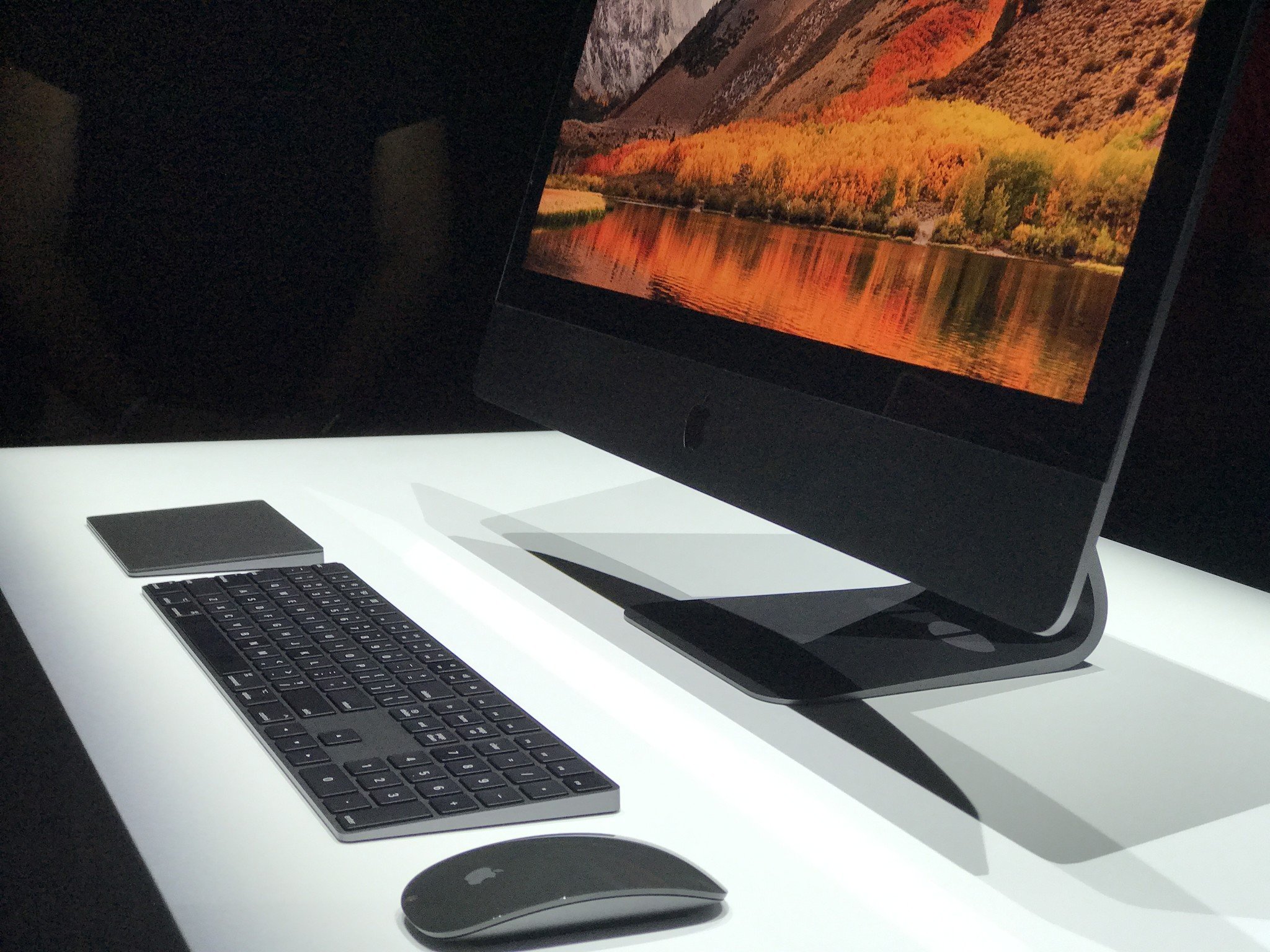
It's not a big, flash update filled with whiz-bang new designs, animations, and workflows. The changes are deep. Deep as the file system, as the graphics engine, as the concept of AI and sync that respect our privacy and security.
As someone who uses macOS every day and has everything from the multitouch trackpad to the keyboard shortcuts on muscle-memory speed-dial, the update to High Sierra has been something I've barely noticed. The was nothing to get used to, nothing to relearn. Everything I do keeps getting done, just faster and better. At least mostly.
I do wish Apple had addressed some of the longer-standing gripes, like the aforementioned lack of HomeKit support, lack of Continuity for media and News for Mac, and the inflexibility of Split View, but they nailed other ones like external editors in Photos. They also gave Safari, the most important app on the platform, so much love.
Apple is positioning macOS High Sierra as an update that prepares the platform for future innovation. That's not just technologies like APFS and Metal 2, and Core ML and eGPU, HEVC and HEIF, but new products like iMac Pro and a new Mac Pro coming later this year and next.
And that's fine. Excellent even. As long as that future delivers.

Rene Ritchie is one of the most respected Apple analysts in the business, reaching a combined audience of over 40 million readers a month. His YouTube channel, Vector, has over 90 thousand subscribers and 14 million views and his podcasts, including Debug, have been downloaded over 20 million times. He also regularly co-hosts MacBreak Weekly for the TWiT network and co-hosted CES Live! and Talk Mobile. Based in Montreal, Rene is a former director of product marketing, web developer, and graphic designer. He's authored several books and appeared on numerous television and radio segments to discuss Apple and the technology industry. When not working, he likes to cook, grapple, and spend time with his friends and family.
